Climate Reports
The power and abundance of our Earth can never be overstated; what is commonly overlooked is humanity’s exploitation and neglect of its own life source. The following are summaries of recent studies conducted on the interrelationships between climate change and four distinct areas: fashion, food, the sea, and mental health. Brief and laced with sobering data, these glimpses into our intricate, reciprocal relationship with the Earth’s changing climate are intended to evoke a sense of personal responsibility and inspire informed action, no matter how humble. Humans have a continuous effect on the planet, yet an impermanent place in its history. Each of us who walks through its lush fields and drinks from its abundant waters has a duty to protect and support the Earth during the short time we are here.
Fourth National Climate Assessment
The report, prepared with the support and approval of 13 federal agencies, and with input from hundreds of government and non-governmental experts, provides a comprehensive look at how climate change will impact the United States.
These Summary Findings represent a high-level synthesis of the material in the underlying report. The findings consolidate key messages and supporting evidence from 16 national-level topic chapters, 10 regional chapters, and 2 chapters that focus on societal response strategies (mitigation and adaptation). Unless otherwise noted, qualitative statements regarding future conditions in these Summary Findings are broadly applicable across the range of different levels of future climate change and associated impacts considered in this report.
“Climate-related risks will continue to grow without additional action. Decisions made today determine risk exposure for current and future generations and will either broaden or limit options to reduce the negative consequences of climate change.
While Americans are responding in ways that can bolster resilience and improve livelihoods, neither global efforts to mitigate the causes of climate change nor regional efforts to adapt to the impacts currently approach the scales needed to avoid substantial damages to the U.S. economy, environment, and human health and well-being over the coming decades.”
Food
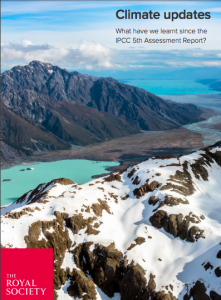
Climate change impacts the health of the Earth and the lives it sustains; as the Earth undergoes many environmental stressors, future access to food is a critical concern for many. The Royal Society’s update of the Intergovernmental Panel on Climate Change (IPCC) 5th Assessment Report provides an analysis of global studies on climate change’s impact on food production. The report indicates that although climate change has varying effects on crop yields across different geographic areas, the aggregate effect of a 2-degree Celsius increase in global temperature will ultimately decrease crop yields. This report specifically examined wheat, rice, and maize—global staples of the human diet. Since 2013, the research also has focused on crop quality. The report suggests that increased carbon dioxide (CO2) emissions and higher temperatures will potentially cause crops like wheat to decrease in nutritional value.
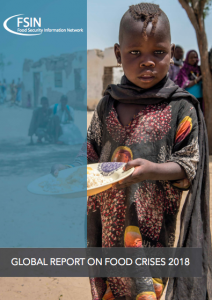 A report by the Food Security Information Network (FSIN) provides further insight into the implications that reduced global access to food and water has for human health. Food insecurity is an intersectional crisis, with political, economic, and environmental factors playing intricate roles. Food security is determined by consistent access to sufficient quantities of food—imported or locally grown—with positive nutritional quality. Food insecurity describes a lack of access to these resources, which can lead to hunger, malnutrition, and famine. It can threaten lives and livelihoods. FSIN reports that, in 2017, 124 million people in 51 countries experienced food insecurity—an increase of 11 million people since the previous year. In 23 countries, extreme climate conditions, including drought, were a primary contributing factor to food insecurity. Areas in eastern and southern African have suffered high incidences of malnutrition due to poor harvests.
A report by the Food Security Information Network (FSIN) provides further insight into the implications that reduced global access to food and water has for human health. Food insecurity is an intersectional crisis, with political, economic, and environmental factors playing intricate roles. Food security is determined by consistent access to sufficient quantities of food—imported or locally grown—with positive nutritional quality. Food insecurity describes a lack of access to these resources, which can lead to hunger, malnutrition, and famine. It can threaten lives and livelihoods. FSIN reports that, in 2017, 124 million people in 51 countries experienced food insecurity—an increase of 11 million people since the previous year. In 23 countries, extreme climate conditions, including drought, were a primary contributing factor to food insecurity. Areas in eastern and southern African have suffered high incidences of malnutrition due to poor harvests.
Conflict, which affects 74 million people across 18 countries, is also a serious obstruction to food security. Countries that have experienced greater food insecurity due to intensified conflict include Myanmar, Nigeria, the Democratic Republic of Congo, South Sudan, and Yemen. In the midst of continued conflict and climate change, the global reality of food security is tenuous and requires international policy implementation and humanitarian efforts. 1, 2
Fashion
Accounting for 8 percent of global greenhouse gas emissions, the fashion industry serves as a key area of research to assess potential measures to ameliorate climate change and rising temperatures. Measuring Fashion, a 2018 study from Quantis, sheds light on the effects that the global apparel and footwear industries have on climate. Due to increased global consumption and greater use of synthetic fabrics, the fashion industry’s greenhouse emissions are projected to spike 49 percent by 2030, reaching 4.9 metric gigatons. These emission levels are comparable to the United States’ total annual emissions today.
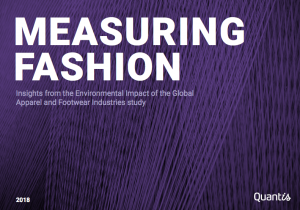
Of the seven distinct stages in a garment’s life cycle, 50 percent of emissions result from just three stages: fiber production, yarn preparation, and dyeing/finishing. These manufacturing processes, which predominantly take place in Asia, are highly dependent on hard coal and natural gases, which generate electricity and heat.
This data, derived from the World Apparel and Footwear Life Cycle Database, offers insight to companies vested in creating evidence-based plans to achieve goals related to improving their environmental impact. To effectively reduce the global environmental impact of the garment lifecycle, Quantis proposes a multifaceted approach, applied strategically to the different parts of the value chain of apparel and footwear. Indeed, suppliers and consumers have a reciprocal responsibility in implementing change. Primary production changes would include reducing the use of fossil fuels and shifting to renewable energy; improving efficiency; and using sustainable fabrics, like cotton, which require less energy-intensive processes. For consumers, the simple objective is to demand less. Sustainability is supported through reduced consumption combined with extending the use phase of a garment (through recycling, donating, and purchasing second-hand clothing).3
The Sea
From producing half of the oxygen on Earth to supporting an abundance of species—91 percent of which have yet to be discovered—the sea is foundational to all life on the planet. Currently, its ability to support life and regulate climate greatly suffers. Foresight Future of the Sea, a UK report conducted by the Government Chief Scientific Advisor, considers the health of the ocean through a lens of economic and environmental implications for the UK and its territories. Yet, the research presented in the report describes a global reality and indicates solutions that require international cooperation and action. Marine ecosystems, as well as humans, face potentially irreversible damage if the many anthropogenic impacts on marine health are not adequately addressed.
The implications of increased anthropogenic CO2 emissions and rising sea temperatures are grave for marine biodiversity. The ocean is a storehouse of CO2—30 percent of which is emitted by human activity. As oceans absorb greater amounts of CO2, the pH of waters drop, causing higher levels of acidity. The increased acidity most notably threatens reef-forming corals and shellfish who struggle to form shells in highly acidic water. According to the report, “Global sea surface temperatures have risen by 0.7°C since pre-industrial times. A further increase of 1.2°C to 3.2°C, depending on emissions, is projected by 2100.” Rising temperatures are highly correlated with species migration and a decline in cold-water species. This could result in local extinctions and the introduction of invasive, warm-water species. Warming temperatures also lead to coral bleaching, which is caused by a disruption of the symbiotic relationship between coral and algae. Algae become physiologically stressed when temperatures rise; they leave their coral, making it susceptible to disease and eventually death. Coral decline increases by up to 2 percent each year, threatening the lives it supports—more than 25 percent of all marine species.
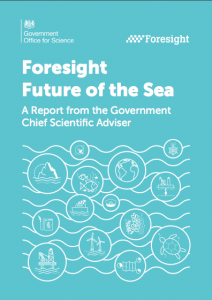
As the ocean warms, sea-levels rise. Between 1901 and 2010, sea-levels rose approximately 20 centimeters. Depending on emission levels, the sea is projected to rise between 0.25 and 1 meter by the year 2100 due to melting polar ice-caps and thermal expansion. Sea-level rise could result in greater coastal flooding during extreme weather, potentially disrupting infrastructure and threatening human lives.
The future of marine health requires greater attention to human activity in the sea and on land. Continuously, human pollution plagues global waters. Chemical pollutants as well as “pharmaceuticals in sewage and agricultural runoff, radioactive waste, noise and light pollution” are all understood to harm marine life. The largest culprit is plastic. Humans produce 300 million tons of plastic globally each year, accounting for 70 percent of pollutants in the ocean. Plastic does not decompose; it simply breaks down into smaller pieces. Between 2015 and 2035, the amount of plastic in the ocean is projected to triple. To avoid this outcome, humans need to prevent plastic from ever entering the ocean and should encourage the introduction and use of more biodegradable products.
The greatest obstacle to protecting the health of the ocean and marine creatures continues to be human consciousness. An attitude of “out of sight, out of mind” leaves the marine environment—one of the greatest supports to human health—neglected and gravely exploited. In addition to research-based policy development and implementation, public awareness and concern are critical to enabling change that will decrease the negative human impact on the marine environment.4
Mental Health and Suicide
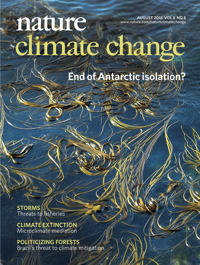
The impact of climate on human physical health has persisted throughout history—from the spread of disease, to incidents of heatstroke, to malnutrition and famine caused by lack of food. Climate’s impact on mental health is of equal importance, as mental illness plagues modern society. Indeed, as we transition into shorter days and longer nights, many people anticipate oncoming seasonal affective disorder. Departing from the study of cyclical seasonal patterns, a study published this year by Marshall Burke et al. in Nature Climate Change examines the impact that rising temperatures have on one of the top causes of death in the U.S.—suicide. Analyzing decades of longitudinal data of temperature change and rates of suicide across the US and Mexico—two countries that account for 7 percent, or nearly 60,000 of global suicides—Burke et al. found that a 1-degree Celsius increase in temperature corresponds to an average of a 1.4 percent rise in suicide rates. This relationship holds true in both warm and cold climates and seasons across these regions; for example, as temperatures rise during winters in Boston and summers in Oaxaca, suicide rates increase.
Controlling for age, gender, and income, as well as ownership of air conditioners and guns—two-thirds of gun deaths are the result of suicide—the relationship between rising temperatures and suicide is consistent. If temperatures continue to rise across the US and Mexico, this study projects an additional 9,000 to 40,000 suicides by 2050. Given that suicide is a phenomenon with multifaceted psychological and sociological underpinnings, the causal relationship between climate and mental health is difficult to support and cannot be considered in isolation. However, this research further illuminates the complexity of this mental illness and the intimate connection between human health and the environment.5
References
- The Royal Society. Climate updates: What have we learnt since the IPCC 5th Assessment Report? 2018.
- Food Security Information Network. Global Report on Food Crises 2018. 2018.
- Quantis. Measuring Fashion: Insights from the Environmental Impact of the Global Apparel and Footwear Industries study. 2018.
- Government Office for Science. Foresight Future of the Sea: A Report from the Government Chief Scientific Advisor. 2018.
- Burke, Marshal et. al. “Higher temperatures increase suicide rates in the United States and Mexico.” Nature Climate Change. July 2018.



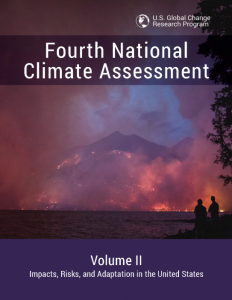




Thank you so much for this excellent article! It is critically important that we all take personal responsibility for our choices in how we are affecting the planet and other life forms. Here is information on the impacts of overfishing–the elephant in the room that is getting very little publicity. We vote with our wallets.
http://ethicalcorp.com/over-fishing-worse-threat-oceans-climate-change?utm_campaign=2019-01-28+Latest&utm_medium=email&utm_source=Pew
Mahalo for your wisdom!